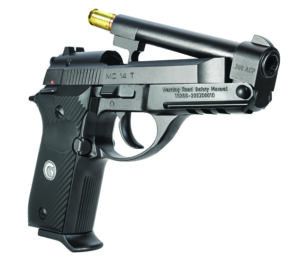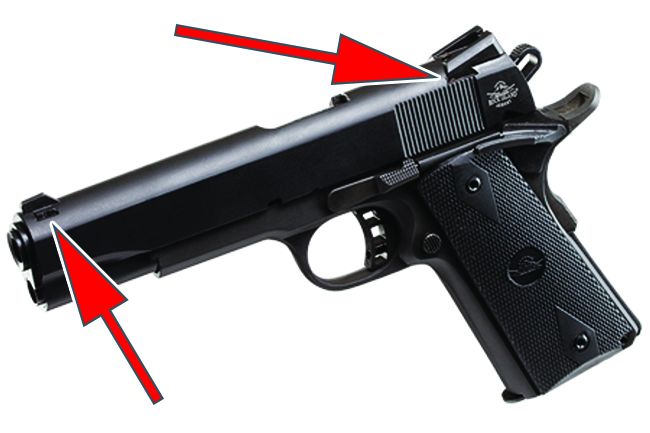I recently purchased a 9mm 1911 Rock Island Armory Standard FS Model 51632. Certainly didn’t need another 1911, but this was a screaming deal and something to play with. The first task was to change the front and rear sights. Starting with the rear, it would not even budge with my sight pusher, and I actually bent the pusher’s frame a little. I contacted RIA, and they said drive it out from left to right with a non-marring brass punch. Well, it should have pushed out that way with the sight pusher. I had read on-line that they use threadlocker on their sights. I applied microtorch heat, trying over and over with the sight pusher, beating on the sight base with a punch and a hammer, and finally the sight comes out of the frame. I noticed red threadlocker in two small depressions on the underside of the sight. Of course, as an amateur gunsmith, I dinged up the dovetail and cocking serrations in the process. I contacted RIA again about this. From the chat with Armscor:
As per our gunsmith, Loctite is used on all of our sights, and some sights may be tighter in the dovetails than others due to manufacturing tolerances.
Why would they use red threadlocker on a sight that has a set screw in the middle to hold it in place?
Now for the front sight. I got a new propane bottle for my torch head, and it had a much better flame than the micro-torch. In the heating process, I melted some of the Delrin on my sight pusher. The sight wouldn’t budge. Clamped the slide in a vise, heated it again, and beat on the blade with a punch and a hammer. Now it comes out. Red threadlocker again.
In summary, I think you should automatically dock every single RIA pistol with fixed sights one letter grade for being essentially non-adjustable. And this might be something to investigate with other fixed-sight pistols you review. How hard is it to move the sight?
In my view, RIA fixed sights are essentially non-adjustable, at least without a very real possibility of damage to the sight or gun or both. Me? I will never buy an RIA product again. I let them know that. — Tom
Hey Tom: It’s hard to fault your efforts. If the sights wouldn’t budge with all the effort you expended, they were pretty danged tight. However, I can’t automatically apply a demerit to any specific company’s products. But this is a situation we can keep an eye on. — Todd Woodard
Lefty (Hand, Not Politics) Tests
I’ve been a subscriber since way back in the 1990s. Your articles have helped me make a lot of important decisions over the years. I am a member of a marginalized group called “lefties” (hand, not politics). Southpaws make up about 15% of the population, and many people who are left-eye dominant also choose to become port-side shooters.
We are requesting a couple of sentences (maybe even a paragraph) describing the pluses and deficiencies of operating each firearm tested from our alternative viewpoint. As an example, many semi-autos tend to leave powder burns in the face of a lefty. Many times a pistol may eject hot brass on the arms or face due to our slight variation of hold and stance. Right-side bolt actions, while not impossible to operate, are usually a bit clunky. Sometimes, firearms are purpose built to be ambidextrous.
There are odd references in the magazine from time to time concerning ambidexterity, but we need reporting on a consistent basis, We are not demanding a left-hand evaluator. If you have one handy, we’re okay with that. We are asking your professional staff to evaluate all firearms from our side of the world and give us a brief summary, as warranted. — Gregory
Gregory: This is a perfectly reasonable ask. Thanks for letting me know about your needs. — tw
Re “Firing Line,” September 2023
Todd, thanks for your rapid response to my question on slide-stop insertion during reassembly of the Mil-Spec Springfield. From his response, Mr. Sadowski seemed to think I was asking for instructions on slide-stop insertion in 1911 pistols. My question was not answered. Was a tool required to insert the slide stop on the Mil-Spec Springfield 1911 in your test, yes or no? — Cathy
Hey Cathy: Robert Sadowski said, “If you insert the slide stop correctly, you do not need a screwdriver to depress the slide-stop plunger.” He was referring to the Mil-Spec Springfield, per your ask. So, no, a tool isn’t needed for this operation on the Mil-Spec Springfield. — tw
Please Test MC14T Tip-Up

Hi Todd, I don’t remember if I already asked you this. I’m 79 now, and I must confess my memory isn’t what it used to be.
That said, please test the EAA/Girsan MC14T Tip-up pistol in 380 ACP. I have a friend whose hands are quite weak. She finds even the Smith & Wesson EZ pistols to be just a little too hard for her to easily rack the slide. She can do it, but not happily. It will be interesting to see if this tip-up pistol has a good trigger; not only the pull weight, but also the feel of the trigger itself. And the sights, of course. And the felt recoil. I’m a little disappointed that this pistol is a double-action rig, in addition to single action. From what I have read over the years in your outstanding magazine, the double-action pull weight is always much higher than single action. That’s why I personally prefer single-action-only pistols, provided the single-action pull weight is reasonable, and the trigger itself is a relatively sweet one. Thanks in advance. — Phil
Phil: We’re on it. — tw
Re “Subcompact High-Capacity 9mm Pistols Shoot It Out,” September 2023
Hi, Todd. I’m a subscriber who reads every issue immediately upon receipt. I had to laugh at the only error I’ve ever seen in Gun Tests. In the specs section for the Taurus 9mm pistol, I read the Slide Retraction Effort was 14.0 ounces. After I laughed out loud, I said to myself, “Even my 90-year-old arthritic and crippled granny could rack that slide with no problem.” With thanks again and best wishes. — Phil
Hey Phil: Thanks to you and other readers who pointed out that mistake. The Slide Retraction Effort for the Taurus GX4XL Standard 1-GX4XL941 9mm Luger should have read 14.0 pounds, not ounces. — tw





























